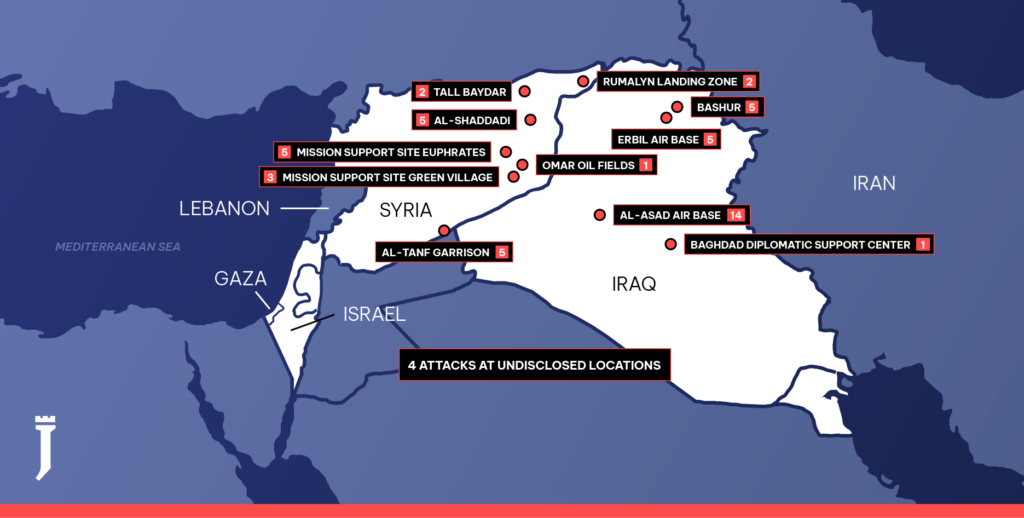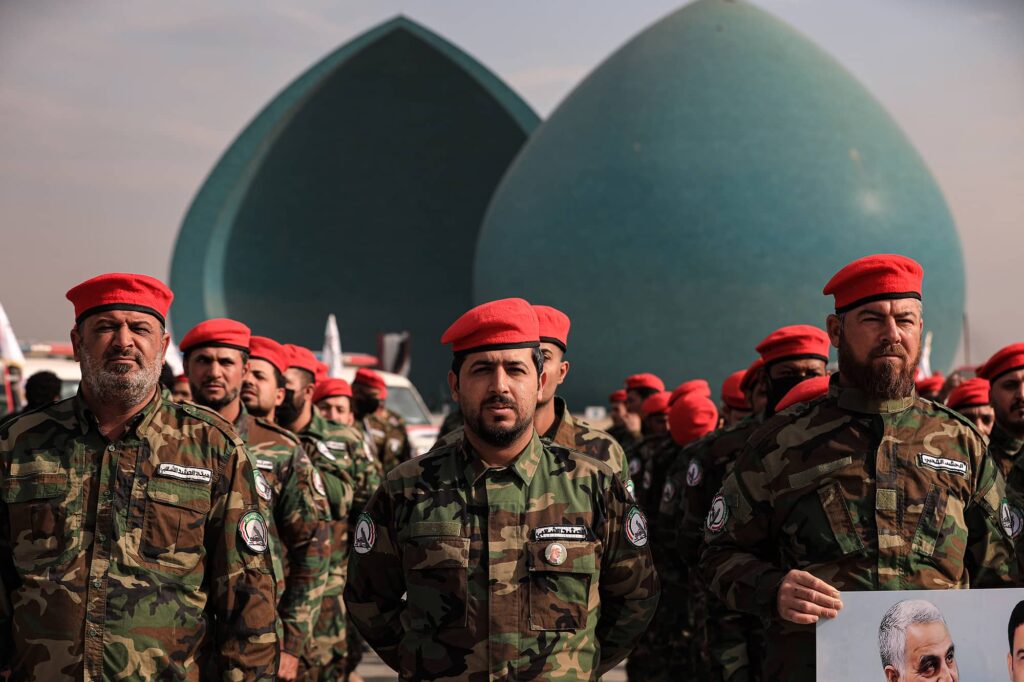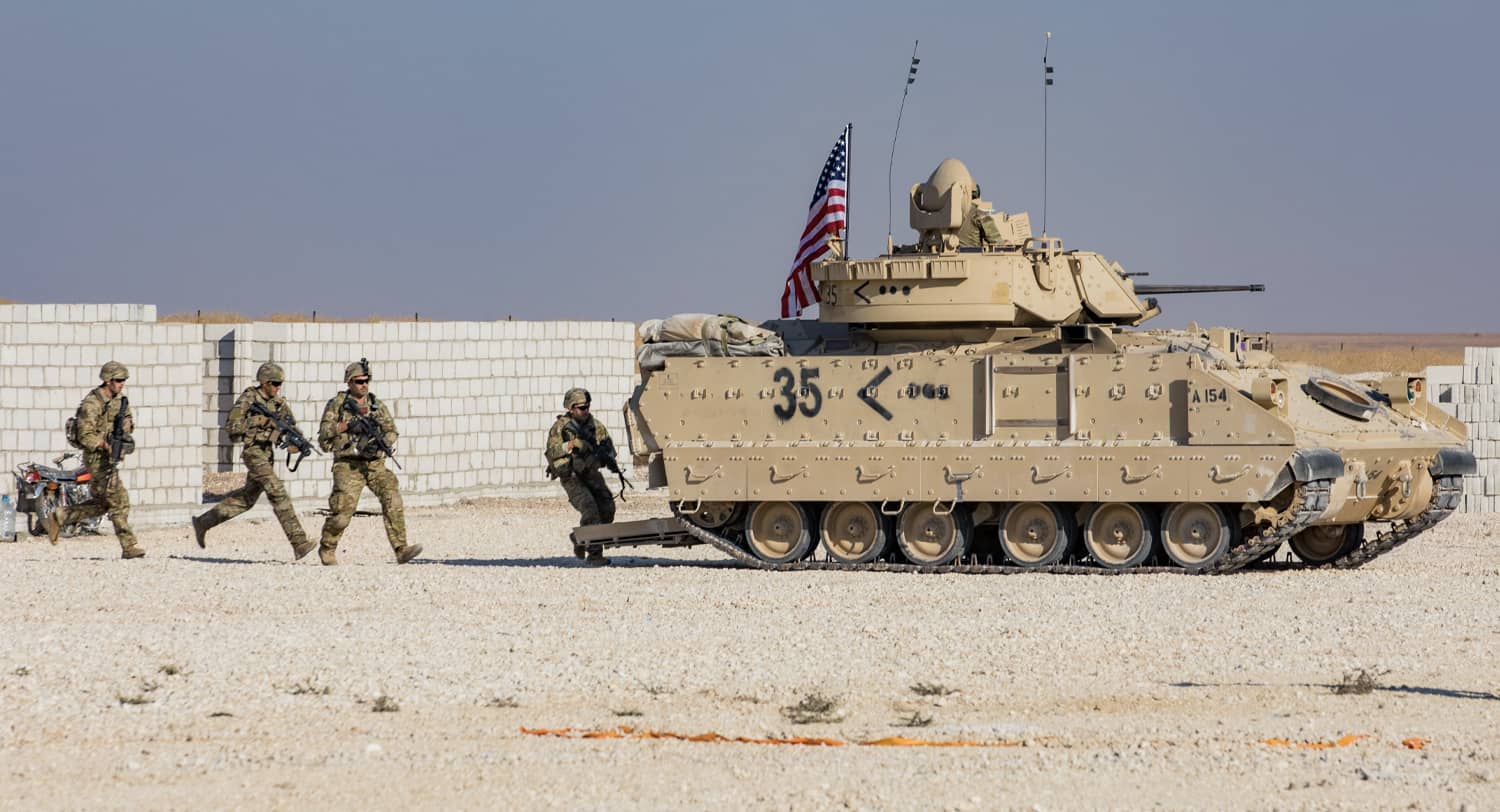In the immediate aftermath of Hamas’s attack on Israel on October 7th and during Israel’s counter-offensive into Gaza, Iranian proxy militias in Iraq and Syria have escalated attacks on US positions in both countries. Fully 60 such attacks have taken place against US forces since October 7. 56 American personnel have suffered injuries in these attacks so far, ranging from minor wounds to traumatic brain injuries. One contractor died of a heart attack in the course of one of the bombings. Reports of conversations with US personnel based in facilities in Iraq and Syria indicate a near constant state of alert, with troops spending considerable amounts of time in bunkers and shelters.
The US has struck back on a number of occasions, as President Biden noted in his Washington Post op-ed of November 19 Three times since October 26, the US has carried out airstrikes on Iran-supported militias in Syria and Iraq in retaliation for the ongoing attacks. The latest such counter strike came on Sunday November 12. According to the opposition-linked, usually reliable Syrian Observatory for Human Rights, which maintains a network of contacts on the ground in Syria, eight members of Iran-backed militias were killed in the latest US strike and seven injured. According to the Observatory, the US counter attack destroyed a weapons depot near Albukamal, on the Syrian side of the Syria-Iraq border, and a rocket launch platform near Mayadin. These areas are located inside an area of de facto Iranian control on both sides of the border.
The US counterstrikes do not at present appear to have been sufficient to deter Iranian attacks. Five additional Iranian strikes have taken place since the Sunday US operation. Why is Iran carrying out these attacks at the present time? And is the current situation likely to deteriorate further into open conflict between the sides, even as the war between Israel and Hamas in Gaza continues, and the situation on the Israel- Lebanon border continues to escalate?

To understand the dynamics of the current situation in Syria and Iraq, it is important first of all to be aware of the dispositions of both Iranian and US forces in both countries, and the state of play between them.
Both the Syrian and Iraqi governments are able to assert only partial sovereignty over the areas which they formally govern. In both countries, the Iranian Revolutionary Guards Corps (IRGC) is managing proxy militias as instruments of Iranian power and influence. The IRGC projects in Syria and Iraq resemble one another but also differ significantly because of the different prevailing political realities in the two countries.
In Syria, Iran and its proxy militias were crucial to the regime’s survival and partial victory in the civil war in the 2012-19 period. Iran has not withdrawn from Syria in the post conflict period. Rather, Teheran’s proxies remain, woven into the fabric of the official state security forces (the Syrian regime remains in many ways a shell, weak and dependent on its Iranian and Russian allies.) The Iranian proxies have access to and freedom of movement within a contiguous area of land extending from the Iraq-Iran border to Quneitra Province on the Syrian side of the Golan border with Israel. This contiguity is interrupted, however, by the US base at Tanf, and the fire zone maintained by the US around it.
Israel’s ’campaign between the wars’ has over the last ten years hit heavily at Iranian efforts to build military infrastructure on Syrian soil. But despite Israel’s campaign, Iranian proxies remain active, strong and not beholden to the regime of President Bashar Assad for their activities, as Ehud Yaari has described recently in the JST.

The presence of 900 US service personnel in eastern Syria, as part of ongoing efforts against ISIS, does significantly disrupt the Iranian project in Syria. These forces underwrite the continued de facto partition of Syria, and the ongoing existence of the Kurdish dominated Autonomous Administration of North East Syria. As such, Iran, along with the Assad regime, Russia and indeed Turkey (despite its support for Islamist insurgents at war with Assad), support the withdrawal of this US force and the destruction of the Kurdish led authority in north east Syria, which the Kurds call Rojava.
In Iraq, the situation differs in that institutions of representative government exist and function. As a result, in a manner more reminiscent of Lebanon than of Syria, Iranian client militias operate as both political parties and militias. The current government of Prime Minister Mohammed Shia al-Sudani rests on the support of the militias in their iteration as political parties.
There are currently 2500 US service personnel deployed in Iraq. Iran is determined to secure the expulsion of these forces. As a result, a sporadic, low-level insurgency by the Shia militias against the US presence has been under way over the last three years (following the conclusion of the war against Islamic State).
Immediately following the October 7 attacks, observers on the ground noted the movement of Iranian client militias in Syria toward the Golan border. On a number of occasions in subsequent days, firing at Israel from Syria has taken place. The first such attack took place on October 10, when a number of shells were fired from Syria at northern Israel. The shells landed in open ground. Israel responded with artillery fire on targets in Syria.
The most significant attack from Syria to date took place on November 9, when a drone was launched which exploded on the Tze’elim elementary school in Eilat on Israel’s southern tip. There were no serious injuries in the blast, but Israel failed to detect the drone on its way to Eilat: It apparently flew over Jordan. Israel responded with a counterstrike on the Imam Hussein Brigades in the Homs area in Syria. This brigade is an Iran-backed group including fighters from a variety of nationalities, which works closely with Hizballah.
Still, the most notable development in Syria (and Iraq) since the commencement of and as a result of the Gaza war is the sharp increase in attacks by Iran-supported militias on US targets. Attacks are taking place almost every day. The US base at Tanf on the Syria-Jordan border, facilities east of the Euphrates such as the Conoco and al-Omar bases in Deir al-Zur province, positions further north such as the Kharab al-Jir base, and bases at Shadadi and Tel Beydar have all been targeted using mortar shells, drones and improvised explosives.
Similarly in Iraq, US personnel and facilities at the Ain al Asad base, al-Harir base and Erbil Airport have been the target of attacks by the militias. Claims of responsibility for the attacks have come from a group calling itself the ‘Islamic Resistance in Iraq.’ This appears to be a generic, catch-all term for the militias in Iraq and Syria.
Evidence suggests that a concerted and centrally planned Iranian campaign is under way. The Syrian Observatory for Human Rights has reported that a joint operations center has been established in the Albukamal area, bringing together various elements of the anti-US effort. the Observatory listed the organizations participating in this center as the Iraqi Popular Mobilization Units, the Zeinabiyun and Fatemiyun militias (comprising Afghan and Pakistani Shias, respectively), and Hizballah’s ‘task force’ in Syria, commanded by an individual known as Haj Mahdi, based in the northern Syrian city of Qamishli.

A recent article by Syrian journalist Samer al-Ahmad, who focuses in his work on north east Syria, reported that this operations center is tasked with coordinating attacks against US forces east of the Euphrates and at the US base in Tanf on the Syria-Jordan border, working with Haj Mahdi’s Hizballah-led force in Qamishli and the Saraya al-Khorasani militia in the same city. Qamishli is the main city in the Kurdis-led area of northern Syria, but it also still contains a regime and regime allied element, which has an area of physical control containing a base in the center of the city. The regime and its allies also control the military airport close to Qamishli.
These various assets in Iraq and Syria have begun a campaign of harassment of and low-level insurgency against US forces in both countries. This decision appears to have been taken following October 7th, and to form part of the Iran-led regional axis’s more general effort at a limited, controlled mobilization against Israel, in line with its stated goal of a ‘unification of the fronts’ – while stopping short of the kind of activities which would be sure to provoke a large-scale response from Israel or from the US.
At present, this controlled, partial mobilization consists of three components: Yemeni Houthi drone and missile attacks against Israel, Lebanese Hizballah’s ongoing and escalating attacks on the Israel-Lebanon border, and the mobilization of militias in Syria and Iraq against US targets and to a lesser extent against Israeli targets. So far, both the Israeli and US responses to these activities have been restrained, intended to avoid deterioration to war. In the Israeli case, this is because of a desire to avoid conflict on more than one front while the IDF is engaged in Gaza. For the US, the desire appears to be to avoid being drawn into a conflict in the Middle East. In this regard, the US decision on November 15 to green light a sanctions waiver for Iran that would grant Teheran access to $10 billion held in escrow accounts, even as the attacks in Syria and Iraq continued, reflects this orientation.
The US limited response thus appears to be related to the Biden administration’s broader Middle East policy, which includes not abandoning the goal of normalizing relations with Iran through inducements, rather than seeing Iran as an enemy to be confronted. On November 19, the US did impose sanctions on six persons affiliated with the Iran-backed Iraqi militia Kataeb Hizbullah. Will ongoing attacks on US positions by Iran-led militias in Syria and Iraq lead to a more robust US response? This will become clear in the days and weeks ahead.

